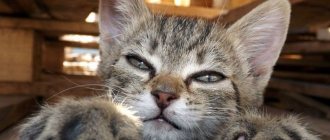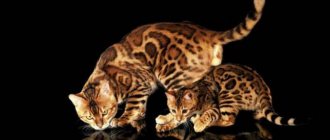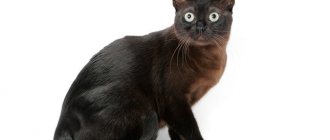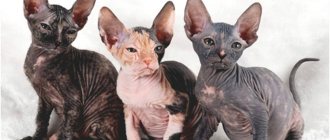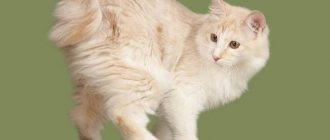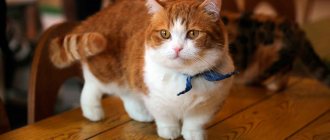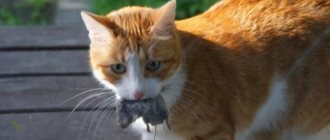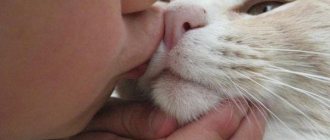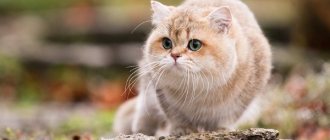Cat owners are well aware of their pets' dislike for water treatments. Getting an animal that licks its fur with such zeal into the bathroom is a big problem.
A cat can sit near the water tap, watch the stream and even drink it, but when it comes to washing, most four-legged pets are categorical - fanning claws and loud dissatisfaction. By the way, this behavior is quite understandable, and we have already written an article about why cats don’t like to get wet, we recommend reading it.
Source: news.myseldon.com
However, dislike of water, as it turned out, is not characteristic of all breeds. Our article will help you find out whether your cat will bask in the bath or jump out of it as if scalded.
Dislike of water
Basically, cats don't like water. This is due to the fact that their ancestors lived in desert areas, and swimming was unusual for them. The second reason is that the wool gets wet. It becomes heavy and sticks to the skin. The cat feels extremely uncomfortable. He seems to be left without a protective shell, so he feels helpless. You've probably seen a picture where a pet, after bathing, hides in a corner and becomes quiet and unnoticeable until the fur dries.
Bengal cat
Show class cat breed. Very active, playful, constantly purring. They do not show aggression, play actively with children, and treat guests with caution. A highly developed intelligence obliges owners to constantly purchase new puzzle toys for their pets. Bengals are large in size, resemble wild cats in appearance, are graceful, flexible, have a spotted color, and short silky hair.
They simply adore water with a real passion; they love to splash in the water and play with toys in it. Frequent bathing is not recommended, but at exhibitions it is mandatory to use shampoos and conditioners to keep the coat beautiful. Cats love to bathe with their owners, but you should not overdo this activity so as not to wash off the protective layer from the skin and fur.
Mandatory process
Cats constantly clean their own fur, licking themselves from the tips of their ears to their tail. For this they can be called one of the neatest animals. However, they still need bathing. It should not be frequent (no more than once every three months), but this process is necessary, since the cat may become ill or become infected with parasites. The owner must take care of his pet and, despite the cat’s dislike for water, try to teach him to bathe from childhood. Create all the conditions to make your pet comfortable and start washing. How to do this correctly, you can find out in more detail on the Internet or consult a veterinarian.
Peach coloring: 10 ideas for creating an incredibly delicate look
Apple does not leave the market in Russia, agreeing to install Russian software
Capricorn and 3 other zodiac signs whose glass is always half empty
And here are those breeds whose owners can consider themselves lucky. Their cats enjoy water treatments.
Maine Coon
This huge representative of the cat family dearly loves water treatments. In life, the Maine Coon is a calm, brave and serious handsome man, a true American. But as soon as he gets close to water, not a trace remains of his prudence, he turns into a mischievous playful cat. Therefore, be careful while taking a bath - you may not be alone in it.
On the Mister Cat portal you can read a large article about Maine Coons, their character, history, and breed standards.
Source: www.nastroy.net
Read the article about the largest Maine Coons on our Planet.
Siberian cat
You might think that a Siberian with such fluffy fur should be afraid of water. However, where have you seen Siberians afraid of something? This is exactly how fearless your pet is. He is ready not only to go hiking in the mountains with you, but will also be happy to accompany you while swimming in the lake, because he is an excellent swimmer.
“Don’t divide yourself into parts”: Tina Kandelaki on how to find your man
Haircuts were not Aunt Tanya’s thing: Menshova remembered her first “stylist”
They wanted to clear the roof of snow and almost ended up under it: video
Turkish van
According to legend, a Turkish Van cat jumped off Noah's Ark in order to end up in Turkey by swimming across the ocean. But, having arrived in this country, he discovered that it was too hot for him there. The only way to cool off was to swim in the cool waters of the blue lake, which the cat did. Representatives of this breed are ready to swim anywhere and for as long as they want. Therefore, do not be alarmed if you find a cat in the toilet or the bath you prepared.
Read about the Turkish Van, one of the oldest cat breeds.
Source: www.vokrugsveta.ru
American Bobtail
www.metaphoricalplatypus.com
This is a young breed, officially recognized about 50 years ago. They are often called “cat-dogs” for their affection for the family, their ability to learn, and their love of water and walking on a leash.
American Bobtails are good at sensing their owner’s mood, which is why they are used in therapy and in the treatment of depression. They get along equally well with all family members, guests and pets. True, they themselves need constant attention, otherwise they may start to feel sad.
What breeds should you avoid?
Felinologists do not recommend having breeds similar to predatory cats: Chausie, Caraquet, Savannah.
They have a developed wild side, so cats use their fangs and claws to protect themselves. For example, representatives of the interracial Savannah breed are labeled F1-F7. The lower the number, the more wild blood the animal has. Such animals are suitable exclusively for aviary keeping.
The Chausie breed is also classified into 4 stages F1-F4. Cats marked F4 differ little in size from domestic cats and have the maximum level of socialization, but still are not suitable for families with children.
Causes of fear
Zoologists at one time paid close attention to this issue. Probably just out of curiosity, but it was worth it: it turned out that mustachioed hunters are not afraid of water at all, and do not want to get wet for completely rational reasons
- Risk of hypothermia. Between the top layer of fur and the cat’s skin there is a “layer” of air - the so-called air cushion. This is a protective layer that is heated by the warmth of the cat's body and prevents the pet from freezing. When wet, wool loses its insulating properties. But why are cats afraid of water and dogs are not? To understand, you need to remember the lifestyle of these two animals. A dog is a pack animal; if it gets cold, it will cuddle up to its fellow tribesman and warm up. The dog hunts, chasing prey - it ran and dried up. The dog tracks game, covering long distances - it has walked and dried off. In addition, they also know how to shake themselves off - droplets of water literally slide off the fur covered with sebum. Now it’s obvious why cats don’t like to swim: there’s no one to snuggle up to, they wait for prey almost without moving, they rarely leave the territory (almost never, to be precise), and they don’t know how to shake themselves off. She lay there and froze while the dog frolicked and dried out. Of course, a pet is unlikely to become hypothermic if it dries out in an apartment, but at the genetic level it “remembers” that wet fur will not protect against the cold.
- Risk of overheating. The same air cushion also protects the cat from overheating, preventing the sun's rays from penetrating deep into the fur. The dog loves to swim, because in hot weather it can breathe by sticking out its tongue. But cats can't do this.
- Increased odor. As written above, the cat lies in wait for its prey, frozen in a shelter. But everything will go down the drain if the victim smells the hunter. Wet wool smells much stronger because when it dries, the body temperature rises. Hunger is a real threat to life and a perfectly reasonable explanation for why cats don't like water.
- Possible attack. The other side of the coin: the “fragrant” wet fur not only scares away prey, but also makes the cat noticeable to larger hunters who can attack at any moment. And here you can’t concentrate, because you need to carefully lick every centimeter of the fur coat! The dog will be warned about the danger by a fellow tribesman, but the cat has no one to count on.
- Dirt, bacteria. Damp fur collects a large amount of dust and dirt, which gets into the cat's stomach during washing. In addition, a humid, warm environment is ideal conditions for the development of all kinds of bacteria, microorganisms, fungi and other “illegals.” It seems incredible that many zoologists believe that one of the reasons why cats do not like to swim is their intuitive “awareness” of the listed consequences of water procedures.
- They don't know her well. Domestic cats are descendants of the wild Nubian (damn) cat living in Northeast Africa. It lives in semi-deserts and deserts, far from large bodies of water. Water is unusual and potentially dangerous for them; these cats cannot swim and instinctively avoid getting into water. This attitude towards water has been preserved in most domestic cats. However, some individuals and entire cat populations have overcome this fear. For example, cats on the Isle of Man, located in the Irish Sea, willingly go into the water and even catch fish there.
The Legend of the Cat's Fear
Once upon a time, during the Great Flood, the animals of the Earth existed peacefully on Noah’s ark, waiting for the end of the flood. The devil crept into their ranks, dreaming of destroying all living things. The minion of hell turned into a fat rat with huge teeth. The devil's spawn began to carry out a dirty deed - the rat began to gnaw at the bottom of the ark in order to flood the saving ship. A smart cat, noticing a rat, realized that it was a messenger of devilish forces and killed the disgusting animal. But Noah, not knowing the background of the events, severely punished the cat for killing the beast and threw the unfortunate purr into the raging ocean.
The animals hastened to help the cat and told Noah about the mistake, pointing to the hole chewed by the rat. The elder repented and returned the cat to the ark. But from that unpleasant moment, the poor cats developed a terrible allergy to water (unlike the dog), and from that time on, cats don’t like rats/mice.
Japanese Bobtail
www.adventurecats.org
Yes, yes, this is the same cat with a raised paw that can be seen in the window of any Japanese store. By the way, it has nothing in common with the American Bobtail; the breed received a similar name only for the absence of a tail.
Due to the special structure of their hind legs, these cats often move by jumping, even in adulthood, which, together with their cute round tail, gives them a rabbit-like appearance. They are smart, active and, like other breeds on the list, fearless about bathing procedures.


